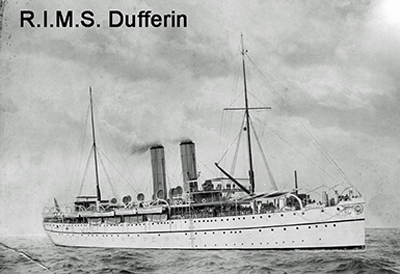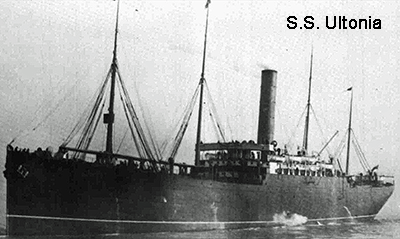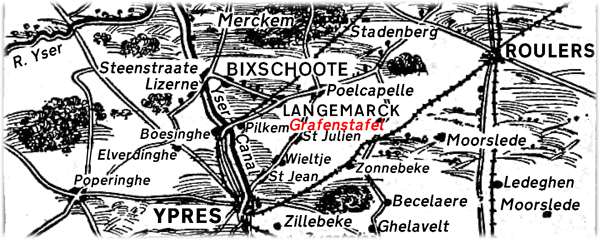First World War Project
George Abraham HALL (of Teynham)
b. Q3, 1884 Lance-Corporal, Service Number L/8484 |
_Memorial.png)
George was one of three surviving sons (Edward Thomas, died soon after birth) of Thomas and Mary Hall of Greenstreet (Teynham side). His father (a Canterbury man) was at different times a chimney sweep, general labourer and occasional petty pilferer - fined in October 1900 for stealing growing damsons owned by Sidney Henban, Teynham. George's younger brother, Benjamin, also served in The Buffs (of which more later). His other brother, Thomas, who is listed as "Next of Kin" at the time of George's paperwork, did not appear to serve.
Around August 1908, George's father died, leaving his widow, Mary, living immediately adjacent to the Teynham Arms, on Greenstreet. In military records, Mary lived both in 9, Arthur Street, Milton Regis, Sittingbourne and in "High Street", Green Street, Teynham, Nr. Sittingbourne". George made her his sole legatee. Consequently she received £16 19s by the close of war (£5 of this sum was "War Gratuity" awarded on 2nd May 1919). George's Plaque, Scroll and medals also went to Mary.
His medical record describes George as a labourer, 5 feet 7½ inches tall, weighing 143lbs, 2 inches chest expansion to 37 inches. Good physical development. Fresh complexion; blue eyes; and light brown hair. He had some vaccination marks from childhood. Some records are badly damaged by water and/or fire.
At the age of 22, George began his army career at Canterbury when he attested on 1st April 1907, joining his Regiment (initially 1st Battalion, The Buffs, then transferred to 2nd Battalion for overseas posting) on 4th April 1907 (confirmed in July 1907). His initial "short" attestment was for seven years followed by five years in the Reserve.
 His first period of training and "Home" service ran for 303 days. On 1st February 1908, George embarked H.M.T. Braemar Castle bound for Harrismith, South Africa, arriving on 27th February. This posting was during a relatively uneventful period in local unrest. He appears to have served without incident. 268 days later, on 21st October 1908, George embarked R.I.M.S. (Royal Indian Marine Ship) Dufferin and disembarked two weeks later in Hong Kong on 20th November 1908.
His first period of training and "Home" service ran for 303 days. On 1st February 1908, George embarked H.M.T. Braemar Castle bound for Harrismith, South Africa, arriving on 27th February. This posting was during a relatively uneventful period in local unrest. He appears to have served without incident. 268 days later, on 21st October 1908, George embarked R.I.M.S. (Royal Indian Marine Ship) Dufferin and disembarked two weeks later in Hong Kong on 20th November 1908.
While serving for 2 years and 58 days in Hong Kong, George was admitted to hospital for 84 days to treat his severe gonorrhoea; only being discharged on 5th January 1910. In April, later that year, George was readmitted for 26 days treatment of Diarrhoea. So, his Hong Kong posting was not a healthy one for this soldier.
 On 5th December 1910, George Hall embarked on R.I.M.S. Hardinge to Singapore - disembarked 10th December 1910 and served there for 2 years and 58 days. Again, no significant actions, just general policing/gunboat diplomacy. His next destination was India (where he required two separate typhoid vaccinations because the first failed). To get there, he joined the R.I.M.S. Northbrook on 28th January 1913, and served for 1 year 288 days before joining the crowded S.S. Ultonia on 16th November 1914 as part of the urgent reorganisation to meet the threat in Europe.
On 5th December 1910, George Hall embarked on R.I.M.S. Hardinge to Singapore - disembarked 10th December 1910 and served there for 2 years and 58 days. Again, no significant actions, just general policing/gunboat diplomacy. His next destination was India (where he required two separate typhoid vaccinations because the first failed). To get there, he joined the R.I.M.S. Northbrook on 28th January 1913, and served for 1 year 288 days before joining the crowded S.S. Ultonia on 16th November 1914 as part of the urgent reorganisation to meet the threat in Europe.
George spent 26 days at "Home" before he joined the British Expeditionary Force on 17th January 1915. The 2nd Battalion was moved immediately to Morn Hill Camp, Winchester, one of the largest WW1 military camps where numbers were brought up to fighting strength.
Thanks to the Army, George had travelled widely, gained significant military experience and promotion to Lance Corporal. Given his length of service, he may have re-enlisted from the Reserve for just one year on return to England. The documents doesn't help firm up on this option for long-service soldiers. Before his untimely death, George had spent 8 years 29 days in the service of his country.
Circumstances of the death of Lance-Corporal George Abraham Hall
The B.E.F. (British Expeditionary Force) was made up of serving and experienced ex-soldiers who were needed to 'hit the ground running'. Their role was to hold back the German army while Territorial Forces were recruited to swell the numbers available in Europe.
Before the Battalion could join the B.E.F., they had to fill gaps in their strength. Initially, they were short of seven officers and 121 men, these gaps had to be found from 3rd Battalion (the Reserve Battalion). They also needed horses, vehicles and signalling equipment. On 6th January, the Regiment moved to Forders Wool Factory, Winchester. Throughout January, the numbers of officers and men needed fluctuated due to illness. In the meantime, soldiers were drilled on firing ranges, practiced transport loading, and took delivery of their machine guns, ready to join the 28th Division, 85th Brigade.
On 12th January, the 85th Brigade was inspected by H.M. The King.
| Friday 15th January 1915 – Western Gazette reported the event |
KING AT WINCHESTER. 20,000 TROOPS REVIEWED. TRIUMPHAL ARCH OF RIFLES. The King accompanied by Lord Kitchener, Major Clive Wigram, and Sir Charles Cust, visited Winchester on Tuesday [12th January] to inspect the division which is mustering there in readiness for active service in Flanders. Also in the train were Sir H. A. Walker (general manager of the railway), Mr. Henry Homes (superintendent of the line), and Supt Robinson (railway police department). The Royal train arrived at Winchester at 10.30 in the morning, and was met by Lieut.-General W.P. Campbell, commanding the Southern District; Major-General E. Bulfin, and other officers. The Royal party motored from the station, through the main streets of Winchester to a point on the Petersfield-road, three miles away, known as the Devil's Punch Bowl, Chesterford Head. The men of the division were lining this road for a couple of miles, and the King passed slowly along the line. As each battalion was reached Lord Kitchener addressed a few words to the men, expressing his satisfaction at their splendid fitness, and saying how proud he was that the men of his old command in India were showing themselves so eager to take their part in the Great War. He said it had been his hope that in such a conflict as this he might have commanded his old Indian Army at the Front, but fate had ordered otherwise. He was sure, however, that they would do their duty with the best, and he knew that if any English division could break the German resistance it was this division now under review. ENTHUSIASTIC TROOPS. The inspection over, the Royal party returned to the station, where, by command of the King the Mayor of Winchester was presented to him by General Campbell. The King expressed his satisfaction at the excellent billeting arrangements made for the troops in Winchester. He said that he recognised that the work of the Winchester officials must have been very heavy, yet it had been admirably carried out, and had greatly added to the comfort and welfare of the troops. He was sure Lord Kitchener would concur in what he said." On 17th January 1915, the 2nd Battalion marched to Southampton and joined the BEF made up of 24 officers, 982 other ranks, 79 horses, 32 vehicles and 8 bicycles. This was 3 fewer "other ranks" than had set out because of illness or fatigue! They embarked on S.S. Inventor bound for Le Havre, where they picked up their interpreters. Via Graville Rest Camp and Hazebruck the 2nd Battalion arrived at Croix Rouge ("close billets") by 21st January which was followed by field training, route marching, drill and inspections. "D" Company (in which George Hall served) had their first experience of living and fighting in trenches from the evening of 6th February at FERME CHAPELLE. New to trench warfare, they recorded how poor the conditions were with knee-deep water and parapets that would not stop a bullet. Trenches went in straight lines without adequate communication trenches, so movements between trench lines were vulnerable to enfilade fire as soldiers were exposed moving between their own trenches. When relieved back to Chateau ROSENDAL (9th February), several men went off sick with swollen feet and frostbite. Throughout February, the 2nd Battalion moved in and out trenches suffering intense machine-gun fire, bombardment, cold and waterlogged trenches as German forces probed canal and other defences around YPRES and OUDERDOM. There were regular losses and injuries among officers and other ranks. From OUDERDOM, the 2nd Battalion were relieved back to LOCRE with the 3rd Division. To get a bath, fresh clothes and rest, on 28th February, the Battalion marched from LOCRE to WESTOUTRE. From LOCRE, the 2nd Battalion moved to DICKEBUSCH to take over the trenches there from 3rd Battalion Royal Fusiliers at ST ELOI. There followed a month of 'turn and turn about' between these two Battalions in the firing line. 4th April (Easter Day), 2nd Battalion marched to YPRES to rest in the Cavalry Barracks but were soon (10th April) taking up their position at the centre of a defence line at the cross-roads for YPRES-MORSLEDE, PASSCHENDAELE-GHELUVELT in close proximity to the German lines. It was also about this time that previously injured or sick soldiers were drafted back to their Battalion at the front. During mid-April, the 2nd Battalion in the trenches at ZONNEBEKE, found themselves under intensifying shelling, part of the German 'softening up' before their major assault. On 13th April, the 2nd Battalion joined an assault on the German trenches, but found themselves seriously hampered by their own wire entanglements (which could not be removed without giving away the intention to attack). |
SECOND BATTLE OF YPRES - GAS AND MAYHEM!
Then all hell broke loose, with the opening of the Second Battle of Ypres between 22nd April and 15th May - hostilities in which George Hall lost his life (2nd May). Personal recollections from members of the 2nd Battalion, of the first few days can be read using this link.
| In the meantime, the regimental diary records.... |
| On 22nd April, 2nd Battalion (The Buffs) sent Lieutenant G. R. Howe to fetch a fresh draft of men to make good the recent losses of officers and men. There follows a story of confusion and desperation around the first use of poison gas. "5pm: Sudden sharp outburst of Artillery fire and rattle of musketry from NW (North West) gradually ceasing and followed a little later by a powerful reek of escaped gas. Half an hour after, French troops appear in scattered twos and threes retiring across the open fields from the N and NW. It was at once apparent that something was wrong, for machine gun and rifle fire sounded within 1,000 yards of ST JEAN and bullets were spattering into the village. Out of this confusion and the gap in defences created, the local military structure was rapidly reconfigured under Canadians in command. The Buffs (without Company "B"): "were ordered to march to WIELTJE and move thence in a northerly direction to get in touch with the left of the 3rd Canadian Brigade. It was after 4am and broad daylight before the battalion was collected and had got under way. Major R.E.Power was in command and put out an advanced guard under Captain Marnard. About 800 yards N of WIELTJE some dug-outs and trenches were reached. These were occupied by Canadians. |
The German deployment of gas against French troops was a game-changer. It created confusion and very nearly punched a hole through Allied defences. Rapid response and leadership by the Canadians helped save that day. But from 22nd onwards, casualties increased sharply. The danger facing George and his comrades was severe, as shown by the loss of Company "B".
On 24th April... |
| "D" Company under Lieut J.B.Sharp was moved into position across the WIELTJE - ST.JULIEN Road at the urgent request of the 3rd Canadian Brigade. |
Losses were severe for the 3rd Royal Fusiliers who had relieved The Buffs in the firing line on 22nd April. The Buffs returned on 27th April to relieve the 3rd Royal Fusiliers in their old trenches in the GRAFENSTAFEL area and they saw a surprising lull in fighting through to the end of the month.

| "May 1st: 8pm: Enemy active in shelling our whole trench line. [Note: By this time, the Regimental Diary had stopped keeping a daily tally of deaths in "other ranks". However, it was during this period that George died, and it appears certain that he was killed during the unanswered shelling of the trenches occupied by The Buffs in the GRAFENSTAFEL area. Many men were buried by the shell fire]
|
And so the battle continued, but without George Abraham Hall ... who fell under the barrage of shelling that destroyed and collapsed many trenches in the LANGEMARK/GRAFENSTAFEL area. His body was never found so he is commemorated on the Ypres/Ieper-Menin Gate, one of 54,400 casualties.
| A summary of losses was given in the Regimental Diary:- |
| "Casualties. 22nd April to 4th May |
Commonwealth War Graves Commission (CWGC) lists 175 men on the Ypres (Menin Gate) Memorial from East Kent (The Buffs) Regiment - who have no marked graves.
Benjamin Hall - brother who had an entirely uneventful war.
Starting his working life as a brickfield labourer working for Mr. R. Mercer; living in Greenstreet.
Private Benjamin Hall - Regimental Number 1394. 2/4th Battalion The Buffs (East Kent Regiment).
Although he was attested at the age of 19 years and 7 months (apparent) in Sittingbourne on 15th March 1912, Benjamin served entirely at Home until his discharge on 24th March 1916 in "consequence of his service being no longer required." His Station was Chattenden Farm Camp.
On signing up, his medical condition was given as "good". He stood at 5 feet and 8 inches; his chest measurement was 35½" with a good 3" expansion. Vision was also good as "6" in both eyes. Physical development: Good
Statement of Services:
15th March 1912: Private: Unit=4th; Preliminary Drill
26th October 1914: Private: Unit 2/4th: Transferred from 5th Battalion
5th August 1914 to 24 March 1916
- Embodied Services
27th June 1915: PRO, BATTALION 71 POSTED {?Provisional Battalion?}{Pay Roll Office?}{Training Battalion?}
Like his brother, he entered his mother Mary Hall as his sole beneficiary if he had been killed.

 World War 1 Pages
World War 1 Pages